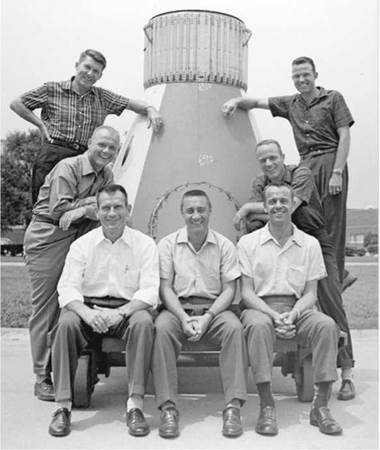MERCURY ASTRONAUTS
Seven American test pilots leapt to instant prominence on 9 April 1959, when NASA formally announced their names at a Washington D. C. press conference, introducing them as the space agency’s Mercury astronauts.
After several weeks of orientation lectures by members of the STG, each of the seven men had been assigned a specific area of specialization and responsibility to pursue. This came about after NASA realized that the entire scope of Project Mercury was so broad, and areas of development so numerous, that it was almost impossible for all seven astronauts to stay in contact with all the latest developments. Thus, at regular meetings, they would individually report on progress and any problems within their specific assignment. This meant that all seven astronauts were kept up to date on the latest developments without the need for them to be involved in studying or contributing to all areas connected with the Mercury program. These assignments were:
Scott Carpenter – Communications and navigation Gordon Cooper – Redstone booster John Glenn – Cockpit layout
Gus Grissom – Electromechanical and autopilot systems Wally Schirra – Life support systems Alan Shepard – Tracking and recovery Deke Slayton – Atlas booster
One aspect of the job in which all seven astronauts played an active part was visiting various contractor facilities in order to familiarize themselves with such things as mockups, hardware, and manufacturing processes. For instance, following his selection as a Mercury astronaut, Marine Lt. Col. John Glenn was assigned the task of working with the McDonnell engineers to help determine the layout of the capsule’s instrument panel. Now, with the basic shape of the spacecraft fully established and approved, final design and development work on the cockpit instrumentation could begin.
|
The seven Mercury astronauts. From left: Wally Schirra, John Glenn, Deke Slayton, Gus Grissom, Alan Shepard, Scott Carpenter and Gordon Cooper. (Photo: NASA) |
First of all, as Glenn recounted in We Seven, “McDonnell had to figure out a way to build [the capsule] so it would be as strong as possible and as light as possible at the same time. The engineers knew that every pound saved on the pad would provide an additional mile in range.”
As he explained, the wall of the capsule was made up of two layers of high-grade metal. “The outer layer consists of shingles made from a metal called Rene 41. These have been corrugated and then welded together to give them extra strength. The welding technique had to be specially perfected so that the thin sheets of metal would not be torn or cracked in the process. The inner layer is made of titanium, a light, strong metal which was developed for jet engines and provides the strength of steel at about half the weight. The two layers are separated by a hollow space that provides extra insulation. It was an extremely difficult vehicle to build, and it was full of compromise. It was not perfect, but it was functional.”19
Gus Grissom’s prime responsibility was working on the Automatic Flight Control System and autopilot, especially for the upcoming orbital missions.
“The path that the capsule follows [after launch] can’t be altered after we come off the Atlas booster. Once we are in orbit, we can’t change that orbit. As we rotate around the Earth, the autopilot will maintain us in a position to be always looking at the Earth – which actually means that the capsule has to be turned 360 degrees each time we go around the Earth. If we want to change the position of our capsule and look in another direction, or if the autopilot should malfunction, we can then take over with the Manual Attitude Control System. To fly the Manual System we have a side arm controller; it is very similar to the control stick in an airplane – except that an airplane has rudder pedals also, while in this we have eliminated the rudder pedals and made it a function of the stick also. We have a three-axis control.”20











